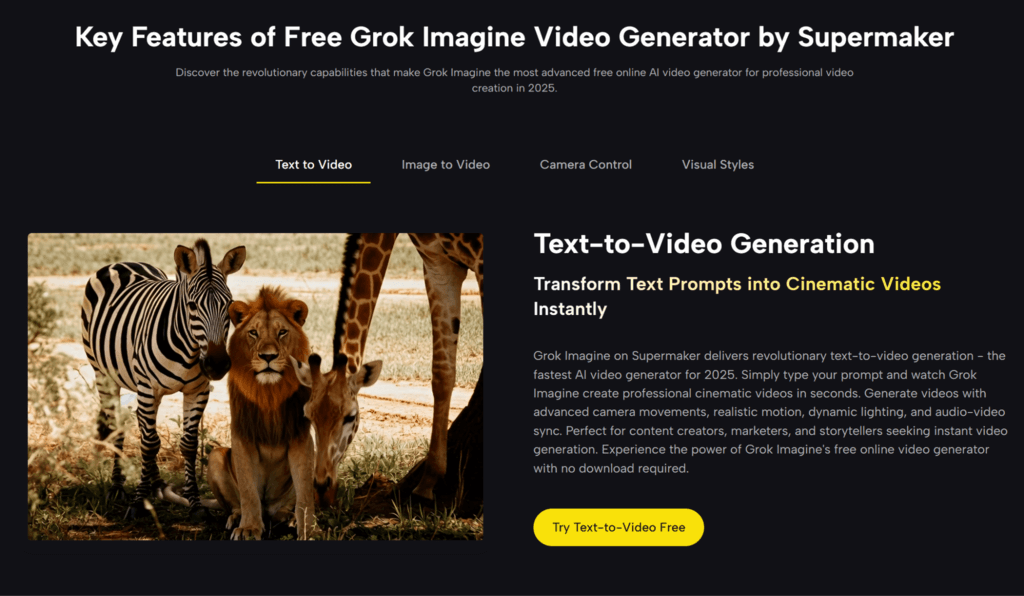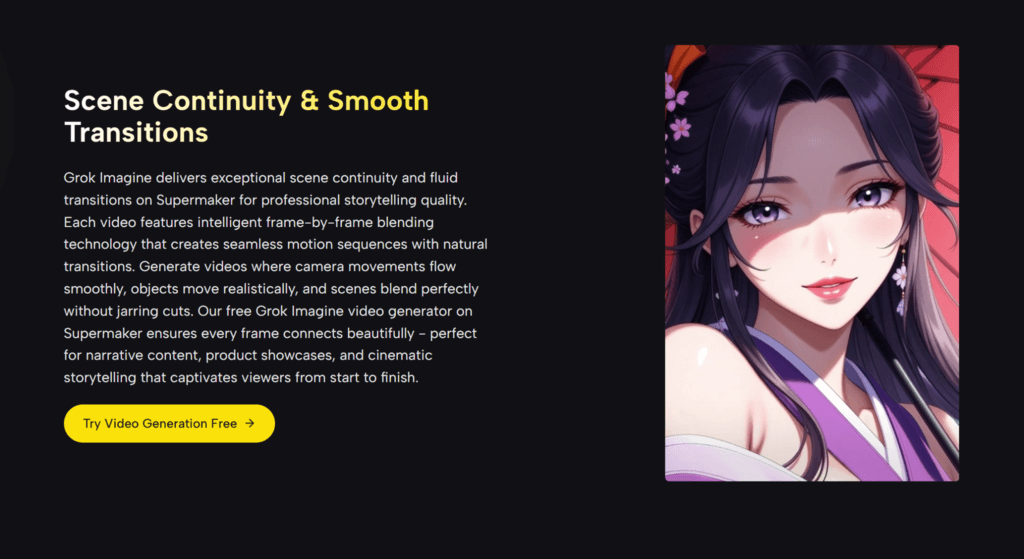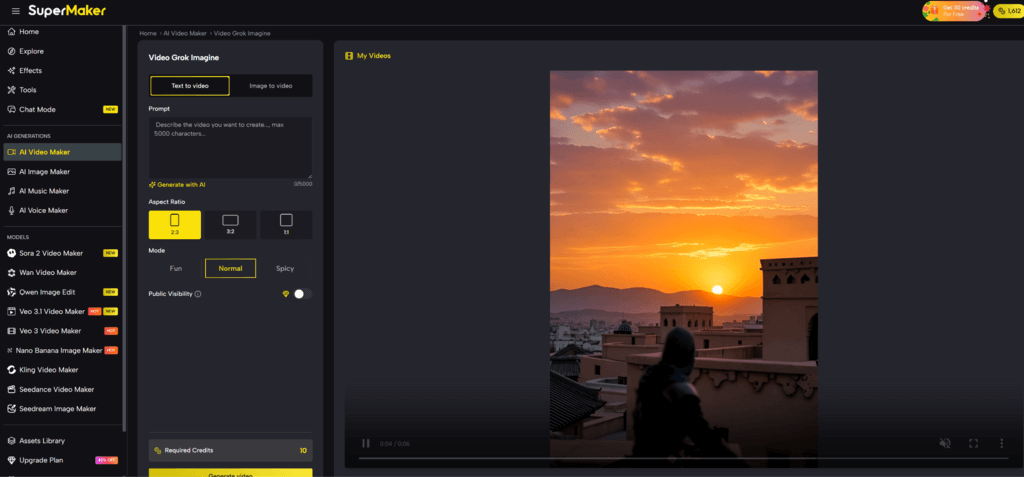You’ve got ideas that deserve to be seen. Maybe it’s a product launch that needs a stunning visual hook, a client asking for a kinetic promo by tomorrow morning, or a concept you’ve been holding onto because briefing a designer feels like a whole project. The problem? Traditional design pipelines are slow, technical, and expensive. You end up compromising: fewer iterations, lower resolution, and less time to explore.
Then the pressure builds. Deadlines loom, expectations rise, and you’re still stitching together assets that don’t quite sing. It’s not that you lack imagination—you’re being blocked by the process.
Here’s the relief: you can now go from natural language to studio-grade images and videos in minutes, not days. Grok Imagine is a new kind of visual creation engine—powered by the Aurora architecture—that translates simple English prompts into high-resolution images and 4K videos with uncanny fidelity. If you can describe it, you can generate it.
I spent last week testing Grok Imagine Generator across portraits, logos, kinetic text clips, and even AI-dance videos. The speed surprised me; the precision sold me.
From Idea to Impact: What Changes When You Use Grok Imagine
Before: You plan, brief, wait, revise, settle.
After: You describe, generate, refine, publish.
That’s the bridge Grok Imagine builds. And it spans both still and moving content:
- Text-to-Image at up to 1024×1024 with realistic lighting, faces, and textures.
- Text-to-Video in 30–60 seconds for most clips, 2 minutes for complex sequences.
- 4K exports that don’t crumble when you scale.
- Natural language control—no keyframes or node graphs required.
Aurora—the engine under the hood—uses a large-scale autoregressive model trained on billions of examples. In practice, it feels like a creative collaborator that keeps your intent intact. When I asked for “a kinetic brand opener with metallic typography morphing into a logo under sunrise light,” it nailed the mood and motion on the second try.
Who It’s For
- Creators and marketers who need high-quality content fast.
- Indie founders who can’t hire a full studio but want premium polish.
- Agencies that want to pitch more ideas without ballooning production costs.
- Educators and storytellers who need visuals to make complex ideas land.
If your work lives on social, in decks, or on screens of any size, Grok Imagine accelerates everything.
What Makes Grok Imagine Different
Aurora Engine Precision
- Trained at scale to understand context, composition, typography, and lighting.
- Strong text rendering—those prompt-based title cards and posters are crisp.
- Multi-modal input: blend text and image references for controlled outcomes.
When I fed Aurora a brand moodboard and a few descriptors—“grainy film aesthetic, offset print feel, hand-drawn geometry”—it reproduced the style without flattening it.
Speed Without Sacrifice
- Most videos render in 30–60 seconds.
- Complex motion or layered effects finish in about 2 minutes.
- Iteration cycles compress to minutes, not days.
I used to budget a day for a 10-second concept test. With Grok Imagine, I tried six variations in the time it takes to draft a single brief.
4K Output That Holds Up Anywhere
- Export for large displays, pitches, and ads without artifacts.
- Scale without fear—text remains sharp, edges stay clean.
Natural Language Control
- Direct English instructions like: “Zoom from a macro texture to a clean logo reveal,” or “Make the dancer’s movement sync with the beat, neon cyberpunk mood.”
- No specialized animation knowledge required.
Versatile by Design
- Portraits, logos, hero visuals, kinetic text, AI dance videos, image animations, VFX-style reveals—Grok Imagine treats them as first-class citizens.
A Simple Workflow You’ll Actually Use
- Upload your image (JPG, PNG, WEBP, GIF). For best results, start with at least 1024×1024.
- Describe the action in plain English: “Turn this still photo into a looped parallax pan with light leaks,” or “Make the logo assemble from glowing particles.”
- Generate. Most videos complete in under a minute.
- Download and publish to your platform of choice.
In my tests, the best outputs came from succinct prompts + 1–2 reference images. Too much instruction can overconstrain; let the engine breathe.
Table: How Grok Imagine Stacks Up
| Feature | Grok Imagine | Traditional Motion Design | Typical AI Generator |
| Output Quality | 4K images and videos; crisp text and clean motion | High, but time-intensive and expensive | Varies; often soft text and artifacts |
| Speed | 30–60s for most videos; ~2 minutes for complex | Days to weeks | Minutes to hours |
| Control Method | Plain English prompts; image references | Keyframes, graphs, plugins | Prompts, limited control |
| Text Rendering | Strong accuracy; poster-ready | Manual layout and rendering | Frequently distorted |
| Multi-Modal Input | Yes (text + image) | Yes (but expert skills needed) | Often limited |
| Cost Efficiency | High—rapid iteration with free daily credits | Costly per revision | Moderate but inconsistent quality |
| Learning Curve | Gentle—no technical background needed | Steep—software + motion literacy | Low to moderate |
Use Cases That Shine
Brand Launch Sprints
- Generate concept boards in hours: logo explorations, hero graphics, motion bumpers.
- Keep stakeholders aligned with fast, tangible visuals.
Social-Ready Video at Scale
- Kinetic captions, looped backgrounds, explainer snippets.
- Rapid variations for A/B testing across platforms.
Music and Performance
- AI dance edits that sync movement with your vibe.
- Surreal stage visuals for DJs and live sets.
Education and Thought Leadership
- Turn abstract concepts into visual metaphors.
- Animate diagrams for better retention.

From Prompt to Production: A Few Real Examples
- Product Teaser: “An ultra-clean rotating product on a matte black stage, soft rim light, glass refractions, 4K close-ups.” Result: a high-end look that felt like a studio shoot—rendered in under a minute.
- Art Poster: “Swiss-style grid, offset print texture, crimson accent bar, condensed sans typography reading ‘Form Follows Function’.” Text fidelity was razor sharp, textures felt tactile.
- Dance Clip: I uploaded a single portrait and asked for “neon cyberpunk choreography, reflective floor, subtle camera sway.” The movement looked stylized yet believable—perfect for short-form platforms.
Try It Free—Iterate Without Hesitation
Grok Imagine offers a free mode with 2 credits daily. That’s enough to test a couple visual directions or iterate an idea before you spend a cent. Once you’re comfortable, scale up to more ambitious runs.
Explore now: Grok Imagine Video Generator
Best Practices for Better Results
- Start with strong references: images set style boundaries better than words alone.
- Be direct in prompts: “matte,” “grainy,” “volumetric light,” “parallax,” “time-lapse.”
- Use 1024×1024+ source images for uploads to preserve detail.
- Iterate in small steps: lock the mood first, then push motion or typography.
- Export in 4K for master files, then downscale for platform-specific specs.
FAQ
Is it really beginner-friendly?
Yes. You control outputs with simple English instructions. No animation software required.
How fast are the renders?
Most videos finish in 30–60 seconds; complex animations can take up to 2 minutes.
What formats can I upload?
JPG, PNG, WEBP, GIF are supported. For best results, use images at least 1024×1024.
Can I export in 4K?
Absolutely. Perfect for presentations, ads, and large displays.
Is there a free tier?
Yes—2 free credits daily so you can explore workflows risk-free.
Final Thought
The future of creative production isn’t about replacing artists—it’s about removing friction. With AI Video Generator Agent, you keep the spark and lose the drag. That’s not just efficient; it’s empowering.

Chase Ortiz is part of the team at PaigeSimple, where he takes care of all the advertising requests. With a sharp eye for detail, Chase makes sure every advertising opportunity is handled smoothly, helping the site grow and reach more people. His ability to manage these tasks efficiently makes him an important part of the team.

